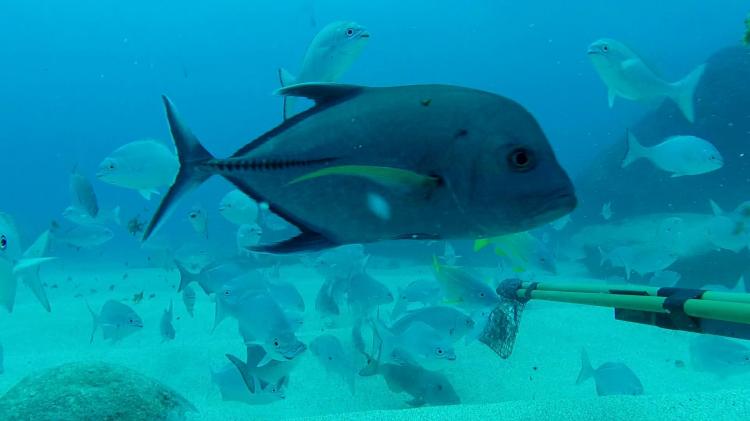Before our fieldwork could commence on Pitcairn, getting the necessary equipment onto this distant isle proved a major logistical challenge. Through a combination of alarmingly overfilled suitcases, serious abuse of airline baggage limits and endless emails to New Zealand freight companies, all of the gear eventually ended up in the right place. I am grateful to my supervisor, Tom Letessier, for his efforts in getting the equipment either shipped in advance or crammed into his bags. Among other things, the inventory for this project includes 18 GoPro cameras, 12 terabytes of hard drives, several miles of duct tape and, most awkward of all, 2 large freezers containing 160kg of pilchards. I will now attempt to explain what exactly we are doing with this pile of technology and frozen fish.
The core component of my work on Pitcairn is a method known as Baited Remote Underwater Videography. As we all know, conservationists like nothing better than a good acronym, and this technique is better known by the very catchy title of BRUV. In brief, two GoPro cameras are attached to a rectangular metal frame, with the cameras focussing on a bait arm which extends in front of the frame. At the end of the bait arm is a wire bag containing pilchards which must be defrosted and mashed up before every day of BRUV-work, a fairly unpleasant task with the aroma of pilchard lingering for hours afterwards.
We have 5 BRUV frames in total, and the frames are being deployed (hurled over the side) from the Pitcairn Island longboat and lowered to the seabed by rope. The cameras are then left to record for an hour before being hauled back to the surface. The primary aim of the footage recorded by these BRUV ‘drops’ is to assess the diversity and abundance of fish species at various sites and depths around the island, in addition to revealing the coverage of different habitat types. The use of bait will ensure that fish are actively attracted to the cameras, allowing for a higher percentage of the total fish assemblage to be sampled than if cameras were deployed without bait.
Black Trevally fish (Caranx lugubris)
Due to its remoteness, Pitcairn’s coastal marine ecosystems have not been extensively studied, and this is the first time that baited cameras have been deployed here. Through this novel method we are hoping to gain new insights into the diversity, composition and health of the fish communities, with the added hope of discovering formerly unrecorded species on Pitcairn. Highlights so far include octopus, tuna, large trevallies and Smith’s Butterflyfish, one of the world’s rarest Butterflyfish species which is only known from Pitcairn and two other tiny Pacific islands. There are also hordes of Gray Drummers (known on Pitcairn as Nanwe), a nondescript silvery fish that descend voraciously on the bait and rip it to shreds. We know that sharks have recently been sighted here, so hopefully they will be tempted into making an appearance on camera. 32 camera drops have been completed so far, and field work will be continuing (depending on the unreliable South Pacific weather) over the next few weeks.
By Henry Duffy

